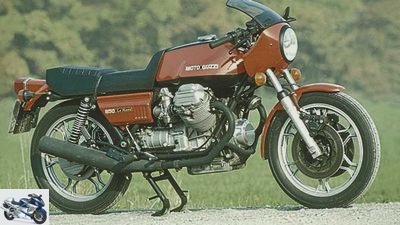Menus

Test: Moto Guzzi 850 Le Mans
The Kulltbike from Moto Guzzi
When the V-Zwo starts, four-stroke fans get goose bumps. The Guzzi is a feast for the eyes and ears.
Anyone who wanted an Italo athlete in the early 1970s picked up the Ducati. Exotic fans bought Laverda, Moto Guzzi supplied the tourers. Clear conditions, at least until the Milan Salon in 1975. At Le Mans, Guzzi presented the thick V-twin-cylinder in a tracksuit. Sportiness was the order of the day, because the Japanese manufacturers were pushing their way to Europe with high-performance machines, and even BMW was making the move with the R 90 S..
D.he Le Mans I was based on the 750 S3 and the 850 T3. A higher compression, larger valves, different carburetors and a sharper camshaft gave the air-cooled twin 71 hp. A narrower handlebar, relocated footrests, perforated brake discs, hump seat, cast wheels, lots of matt black on the frame and exhaust system as well as the partially bright orange painted half-shell cover provided the sporty packaging.
archive
Moto Guzzi 850 Le Mans III
Because a completely new model had to be presented as often as possible in the 1970s, there was soon a Le Mans successor: the Le Mans II, presented at the IFMA in Cologne in 1978. Full angular fairing, some cosmetics, three more horsepower, one another bench – that’s it.
The third Le Mans edition came in 1981. Open intake stacks were now a thing of the past, the exhaust system was also adapted to the more stringent noise regulations, and the engine innards were given a major overhaul. The 76 hp Le Mans III with the angular cylinders and the new half-shell fairing sold well.
In the long run, however, Guzzi had to counteract the competition’s displacement arms race: the Le Mans 1000 presented at the end of 1984. 81 hp were nice, but their unsuccessful design, which emulated the Japanese, marked the beginning of the end of the Le Mans series . The fashionable 16-inch front wheel significantly worsened the super-stable handling. The Le Mans V, which was built from 1988 to the end of 1992, returned to the 18-inch model and the well-known chassis strengths, but time had overtaken Le Mans.
Related articles
-
On the move with the BMW R 100 RS, Kawasaki Z 900 and Moto Guzzi 850 Le Mans
Rivas 39 pictures Arturo Rivas 1/39 The old controversial question of what makes really fast has moved bikers for generations: high performance, good aerodynamics or …
-
Famous motorcycles: Moto Guzzi 850 Le Mans
Gori Famous motorcycles: Moto Guzzi 850 Le Mans When eagles still flew, eagle wings are majestically emblazoned in the Moto Guzzi logo. At the time of the 850 Le …
-
Bilski Test Moto Guzzi Norge 1200 GT Velvet instead of special With the Norge, Moto Guzzi finally says goodbye to the image of the coarse racing cars ….
-
Driving report Moto Guzzi Stelvio 1200 4V
Moto Guzzi Driving report Moto Guzzi Stelvio 1200 4V Alpine swingers Mighty, fateful: the Moto Guzzi Stelvio is as impressive as the Stelvio Pass, after…
-
Driving report Moto Guzzi 1200 Sport
Artist Driving report Moto Guzzi 1200 Sport Long live the sport Since Moto Guzzi has been under the wing of Aprilia and thus ultimately Piaggio, the…
-
On the move: BMW R 100 S, Honda CB 900 F Bol d’Or, Moto Guzzi Le Mans I.
fact On the move: Big Bikes of the 70s BMW R 100 S, Honda CB 900 F Bol d’Or, Moto Guzzi Le Mans I Contents of At the change of the decade, MOTORRAD asks …
-
Driving report Moto Guzzi V7 Classic
Moto Guzzi 3 photos Moto Guzzi 1/3 Moto Guzzi 2/3 Moto Guzzi 3/3 Driving report Moto Guzzi V7 Classic The magnificent seven It was the most famous Guzzi…
-
Driving report Moto Guzzi Norge GT 8V
Photos: Moto Guzzi Driving report: Moto Guzzi Norge GT 8V New tourer from Moto Guzzi Moto Guzzi was once a touring force. Now the completely renewed…
-
Kawasaki ZXR 1100 versus Moto Guzzi V11 Sport
Kawasaki ZXR 1100 versus Moto Guzzi V11 Sport Japan versus Europe: Naked Bikes Motorcycles without filters: Naked Bikes, pure driving pleasure. Kawasaki ZXR 1100 against …
-
Cult bike Moto Guzzi 1100 Sport
Archive Cult bike Moto Guzzi 1100 Sport Liberation Actually it should have been called Le Mans, but also welcomed under a less spectacular name …